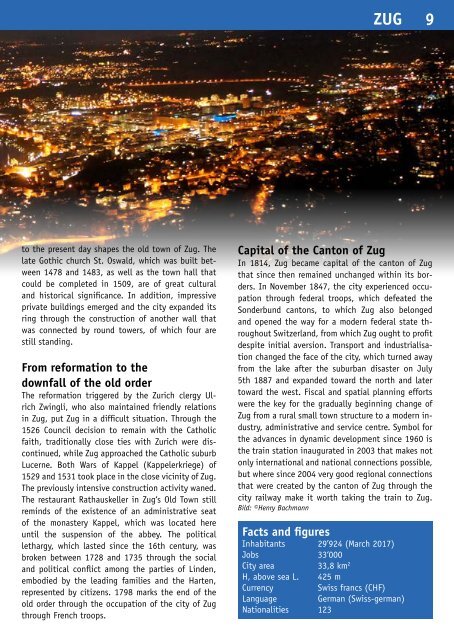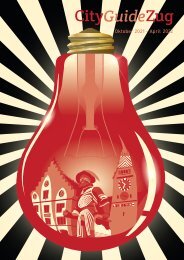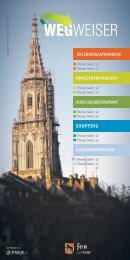CityGuideZug
Oktober 2017 - April 2018
Oktober 2017 - April 2018
Erfolgreiche ePaper selbst erstellen
Machen Sie aus Ihren PDF Publikationen ein blätterbares Flipbook mit unserer einzigartigen Google optimierten e-Paper Software.
ZUG 9<br />
to the present day shapes the old town of Zug. The<br />
late Gothic church St. Oswald, which was built between<br />
1478 and 1483, as well as the town hall that<br />
could be completed in 1509, are of great cultural<br />
and historical significance. In addition, impressive<br />
private buildings emerged and the city expanded its<br />
ring through the construction of another wall that<br />
was connected by round towers, of which four are<br />
still standing.<br />
From reformation to the<br />
downfall of the old order<br />
The reformation triggered by the Zurich clergy Ulrich<br />
Zwingli, who also maintained friendly relations<br />
in Zug, put Zug in a difficult situation. Through the<br />
1526 Council decision to remain with the Catholic<br />
faith, traditionally close ties with Zurich were discontinued,<br />
while Zug approached the Catholic suburb<br />
Lucerne. Both Wars of Kappel (Kappelerkriege) of<br />
1529 and 1531 took place in the close vicinity of Zug.<br />
The previously intensive construction activity waned.<br />
The restaurant Rathauskeller in Zug‘s Old Town still<br />
reminds of the existence of an administrative seat<br />
of the monastery Kappel, which was located here<br />
until the suspension of the abbey. The political<br />
lethargy, which lasted since the 16th century, was<br />
broken between 1728 and 1735 through the social<br />
and political conflict among the parties of Linden,<br />
embodied by the leading families and the Harten,<br />
represented by citizens. 1798 marks the end of the<br />
old order through the occupation of the city of Zug<br />
through French troops.<br />
Capital of the Canton of Zug<br />
In 1814, Zug became capital of the canton of Zug<br />
that since then remained unchanged within its borders.<br />
In November 1847, the city experienced occupation<br />
through federal troops, which defeated the<br />
Sonderbund cantons, to which Zug also belonged<br />
and opened the way for a modern federal state throughout<br />
Switzerland, from which Zug ought to profit<br />
despite initial aversion. Transport and industrialisation<br />
changed the face of the city, which turned away<br />
from the lake after the suburban disaster on July<br />
5th 1887 and expanded toward the north and later<br />
toward the west. Fiscal and spatial planning efforts<br />
were the key for the gradually beginning change of<br />
Zug from a rural small town structure to a modern industry,<br />
administrative and service centre. Symbol for<br />
the advances in dynamic development since 1960 is<br />
the train station inaugurated in 2003 that makes not<br />
only international and national connections possible,<br />
but where since 2004 very good regional connections<br />
that were created by the canton of Zug through the<br />
city railway make it worth taking the train to Zug.<br />
Bild: ©Henry Bachmann<br />
Facts and figures<br />
Inhabitants 29’924 (March 2017)<br />
Jobs 33‘000<br />
City area 33,8 km 2<br />
H, above sea L. 425 m<br />
Currency Swiss francs (CHF)<br />
Language German (Swiss-german)<br />
Nationalities 123


















